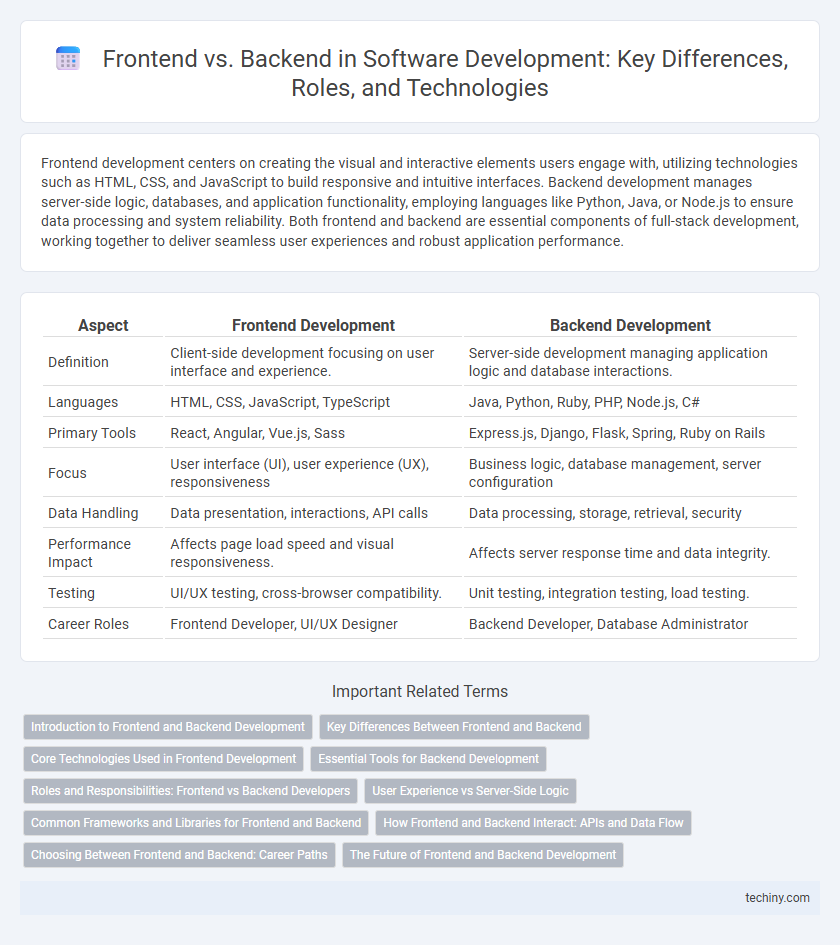Frontend development centers on creating the visual and interactive elements users engage with, utilizing technologies such as HTML, CSS, and JavaScript to build responsive and intuitive interfaces. Backend development manages server-side logic, databases, and application functionality, employing languages like Python, Java, or Node.js to ensure data processing and system reliability. Both frontend and backend are essential components of full-stack development, working together to deliver seamless user experiences and robust application performance.
Table of Comparison
| Aspect | Frontend Development | Backend Development |
|---|---|---|
| Definition | Client-side development focusing on user interface and experience. | Server-side development managing application logic and database interactions. |
| Languages | HTML, CSS, JavaScript, TypeScript | Java, Python, Ruby, PHP, Node.js, C# |
| Primary Tools | React, Angular, Vue.js, Sass | Express.js, Django, Flask, Spring, Ruby on Rails |
| Focus | User interface (UI), user experience (UX), responsiveness | Business logic, database management, server configuration |
| Data Handling | Data presentation, interactions, API calls | Data processing, storage, retrieval, security |
| Performance Impact | Affects page load speed and visual responsiveness. | Affects server response time and data integrity. |
| Testing | UI/UX testing, cross-browser compatibility. | Unit testing, integration testing, load testing. |
| Career Roles | Frontend Developer, UI/UX Designer | Backend Developer, Database Administrator |
Introduction to Frontend and Backend Development
Frontend development involves creating the visual components and user interfaces of a website or application using languages like HTML, CSS, and JavaScript. Backend development focuses on server-side logic, databases, and application functionality using technologies such as Node.js, Python, Ruby, or Java. Both frontend and backend work together to deliver a seamless user experience by managing client-side interactions and server-side processes.
Key Differences Between Frontend and Backend
Frontend development focuses on designing and implementing the user interface using technologies like HTML, CSS, and JavaScript, aiming to create an interactive and visually appealing user experience. Backend development handles server-side logic, databases, and application integration through languages such as Python, Java, and Node.js, ensuring data management and system functionality. Key differences include frontend dealing with client-side interactions and responsiveness, while backend manages data processing, server communication, and security protocols.
Core Technologies Used in Frontend Development
Frontend development relies heavily on core technologies such as HTML for structuring content, CSS for styling and layout, and JavaScript for interactivity and dynamic features. Frameworks and libraries like React, Angular, and Vue.js enhance development efficiency by providing reusable components and state management. These tools work together to create responsive, user-friendly interfaces essential for modern web applications.
Essential Tools for Backend Development
Essential tools for backend development include server-side programming languages such as Python, Java, and Node.js, which enable robust application logic and database interactions. Frameworks like Express.js, Django, and Spring Boot streamline API development and facilitate scalable architecture. Database management systems like PostgreSQL, MongoDB, and MySQL are critical for efficient data storage and retrieval, while containerization tools such as Docker ensure consistent deployment across different environments.
Roles and Responsibilities: Frontend vs Backend Developers
Frontend developers specialize in creating user interfaces using HTML, CSS, and JavaScript frameworks to ensure responsive, accessible, and visually appealing web applications. Backend developers handle server-side logic, database management, API development, and application performance optimization using languages like Python, Java, or Node.js. Both roles collaborate to create seamless, efficient, and secure software solutions by integrating client-side functionality with robust server-side processes.
User Experience vs Server-Side Logic
Frontend development prioritizes user experience by creating intuitive interfaces, responsive design, and seamless interactions that engage users effectively. Backend development focuses on server-side logic, managing databases, authentication, and application performance to ensure reliable functionality and data integrity. Together, frontend and backend collaboration delivers a cohesive software application that balances aesthetic appeal with robust operational support.
Common Frameworks and Libraries for Frontend and Backend
React, Angular, and Vue.js dominate frontend development with their robust component-based architectures and efficient DOM manipulation. On the backend, Node.js, Django, and Ruby on Rails offer scalable and flexible server-side solutions, supporting RESTful APIs and database interactions. Full-stack developers leverage these frameworks to create seamless, performant web applications by integrating frontend interfaces with backend logic.
How Frontend and Backend Interact: APIs and Data Flow
Frontend and backend interact primarily through APIs, which serve as intermediaries for data exchange and functionality requests. The frontend sends user inputs and requests to backend servers via RESTful or GraphQL APIs, which process the data and return responses in formats like JSON or XML. This seamless data flow enables dynamic content rendering, real-time updates, and smooth user experiences across web and mobile applications.
Choosing Between Frontend and Backend: Career Paths
Choosing between frontend and backend development depends on your passion for user interface design or server-side logic. Frontend careers emphasize skills in HTML, CSS, JavaScript, and frameworks like React or Angular, focusing on seamless user experiences. Backend roles prioritize proficiency in databases, server management, and languages such as Python, Java, or Node.js to build scalable and secure applications.
The Future of Frontend and Backend Development
Advancements in AI-driven frameworks and edge computing are reshaping the future of frontend and backend development, accelerating performance and user experience optimization. Frontend development increasingly leverages progressive web apps (PWAs) and static site generators like Next.js, emphasizing responsiveness and interactivity. Backend development is shifting towards serverless architectures and microservices, enhancing scalability, security, and seamless integration with cloud platforms such as AWS and Azure.
Frontend vs Backend Infographic

 techiny.com
techiny.com